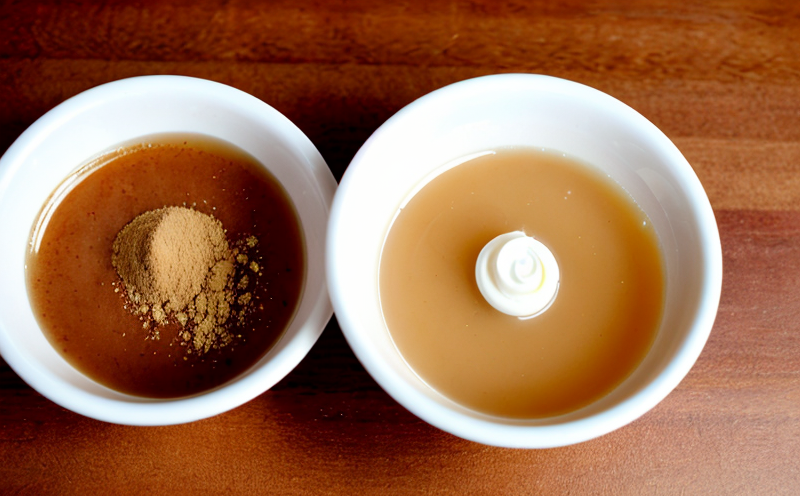ASTM E1885 Flavor Chemical Analysis in Beverages
The ASTM E1885-09(2023) standard provides a comprehensive approach to flavor chemical analysis of beverages. This method is crucial for ensuring the quality, consistency, and safety of sweetener and flavor additives in beverages. The test procedure involves detailed extraction and analysis steps that are designed to identify and quantify key flavor compounds, sweeteners, and other ingredients used in the formulation process.
The ASTM E1885 methodology focuses on evaluating the volatile and non-volatile components present in a beverage sample. This includes a variety of chemicals such as aldehydes, ketones, esters, acids, alcohols, and sugars that contribute to the overall flavor profile. The procedure is particularly important for industries where the taste and aroma are critical factors, like soft drinks, juices, teas, and functional beverages.
The testing process begins with the collection of a representative sample from the beverage product. This sample is then prepared by diluting it with an appropriate solvent, typically methanol or ethanol, to ensure that all flavor compounds are extracted effectively. The preparation step also involves filtering out any particulate matter to avoid interference in the subsequent analysis.
The prepared sample undergoes several analytical steps using advanced instrumentation such as gas chromatography (GC) and mass spectrometry (MS). GC-MS is particularly useful for separating complex mixtures of volatile compounds based on their boiling points. This separation allows for precise identification and quantification of individual components. The results are then compared against a reference standard to ensure accuracy.
The ASTM E1885 method also includes a detailed step-by-step procedure for the analysis of non-volatile flavor compounds, which may require additional extraction techniques such as supercritical fluid extraction or solid-phase microextraction (SPME). These methods help in isolating and concentrating trace amounts of non-volatile components that are crucial for the overall taste experience.
The final step involves evaluating the sensory attributes of the beverage alongside the chemical analysis. This is important because while chemistry provides a quantitative measure, human perception plays a critical role in determining the acceptability of the flavor profile. Sensory evaluation can be conducted using trained panelists who assess various aspects such as sweetness, bitterness, sourness, and umami.
The results from both the chemical analysis and sensory evaluation are compiled to form a comprehensive report that provides insight into the composition and quality of the beverage product. This information is invaluable for quality managers, compliance officers, R&D engineers, and procurement teams who need to ensure that their products meet regulatory standards and consumer expectations.
Compliance with ASTM E1885 ensures that manufacturers can confidently market their products in a global context where rigorous testing is essential. It also aids in identifying potential issues early in the product lifecycle, thereby saving time and resources later on.
Scope and Methodology
The scope of ASTM E1885-09(2023) covers the determination of flavor chemicals present in beverages using a combination of gas chromatography-mass spectrometry (GC-MS) and sensory evaluation. The method is designed to analyze both volatile and non-volatile components that contribute to the overall flavor profile of the beverage.
The methodology includes several key steps:
- Sample preparation by dilution with an appropriate solvent
- Filtration to remove particulate matter
- Volatile component analysis using GC-MS
- Non-volatile component extraction and analysis (if required)
- Sensory evaluation by trained panelists
The standard specifies detailed protocols for each step, ensuring consistency and accuracy in the testing process. Compliance with ASTM E1885 is essential for manufacturers aiming to meet international quality standards and regulatory requirements.
Eurolab Advantages
At Eurolab, we pride ourselves on offering unparalleled expertise in chemical analysis services. Our team of highly qualified scientists and engineers ensures that every test conducted adheres strictly to the ASTM E1885-09(2023) standard. Here’s why choosing us for your flavor and sweetener testing is advantageous:
- Accurate and Reliable Results: Our state-of-the-art laboratories equipped with advanced GC-MS instruments guarantee precise measurements of all flavor chemicals.
- Comprehensive Reporting: We provide detailed reports that include both chemical analysis results and sensory evaluation data, offering a holistic view of your product's quality.
- Expertise in Regulatory Compliance: Our team keeps abreast of the latest standards and regulations to ensure your products meet all necessary requirements.
- Global Recognition: Eurolab’s tests are accepted worldwide, making it easier for you to export your products internationally.
- Rapid Turnaround Times: We understand the importance of timely results. Our efficient processes allow us to deliver reports quickly without compromising on accuracy.
- Cost-Effective Solutions: By ensuring first-time compliance, we help you avoid costly re-tests and product recalls.
- Dedicated Support Throughout the Process: Our customer service team is always available to assist with any queries or concerns you may have.
- Continuous Improvement: We regularly update our methods and instrumentation based on the latest scientific advancements to stay at the forefront of testing technology.
We are committed to delivering exceptional service that meets your specific needs, whether you are a small startup or a large multinational corporation. Let us help you ensure the highest quality in your beverage products.
International Acceptance and Recognition
- American Society for Testing and Materials (ASTM): ASTM E1885-09(2023) is widely recognized and used globally. It is accepted by regulatory bodies in the United States, Europe, Asia, and other regions.
- European Standardization Organizations: The method aligns with European regulations and standards set by organizations like CEN (European Committee for Standardization).
- International Organization for Standardization (ISO): While ASTM E1885 is not directly an ISO standard, it is harmonized with ISO guidelines for chemical analysis.
- World Health Organization (WHO): The WHO recognizes the importance of flavor and sweetener testing in ensuring public health and safety.
The widespread acceptance of ASTM E1885 means that your results are easily transferable across different markets, reducing the need for multiple tests in various regions. This global recognition also enhances your product’s reputation and trustworthiness among consumers worldwide.





